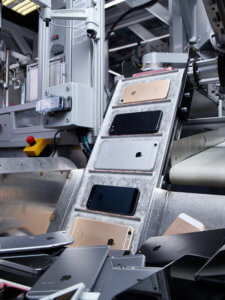Can new tech avoid sacrificing the environment?
Companies like #Apple and #Samsung have led the world of cellphone design for years, and a key part of their strategy is to release a new phone every single year. We’re all guilty of wanting the newest tech in our pockets, but there are ways to stay green without this environmentally harmful practice. I think it’s time they changed. What’s really wild to me is that their phenomenal marketing machines can convince people to trade in an 8-month-old phone for their latest device with ease — and claim to be environmentally friendly while doing it. Whether it’s the new Vision Pro, the latest Apple Watch, or the latest phone, let’s look at some of the problems caused by yearly product releases.
Each year, without fail, new phones are released with shiny new features, a slightly different design, different colors, and upgraded cameras. It has the “world’s first” this or that, and millions of dollars are spent on advertising budgets to make it seem like your current phone is garbage. Carriers also pile in on the craze, offering great trade-in deals so people can buy the latest and greatest smart device yearly. Many people simply use their phones for news, apps, messaging and the occasional games. For them, a yearly upgrade makes little to no sense, but the pressure to upgrade is immense, and there’s an entire system dedicated to getting you a new phone every year.
More than just an update on one piece of technology
With each new phone release comes a different shape. To accommodate this, new cases need to be manufactured to fit these products. Each year, millions of phone cases need to be manufactured to match the dimensions and button placement of the newest phones, and the old ones are headed for discount shelves and eventually the trash. This is a tool for companies to signal to potential customers that you have a new phone, and it really isn’t necessary. Let’s use Apple as an example here: They claim to be “green” and use recycled materials in their cases, but I highly doubt the $8 case most people buy from Amazon uses environmentally friendly materials or even recycles their old inventory.
A new form factor also means engineers need to redesign the components that go inside each device to fit the new format. Camera modules, the motherboard, buttons, and the battery all slightly differ from version to version. As a result, unused components are eventually scrapped when the product reaches end of life. One solution would be to sell the excess parts to consumer phone repair companies, but Apple is among the culprits that are notorious for designing devices that are hard to repair outside of their official channels, even using software tricks to lock out the replacement of cameras or sensors.
What do companies like Apple really mean when they say recycling?
Let’s remember the saying “reduce, reuse, recycle.” It’s in order of priority. Reducing the amount of things we make and reusing what we already have both are far better for the planet than recycling. Some parts of an iPhone, like the aluminum casing, are fairly easy to recycle and introduce back into the supply chain. Plastics are harder and have a limited market due to material degradation. The special glass used on the front and back of iPhones probably goes directly into the trash, as do the majority of the battery and circuit board components. Apple has invested in robots designed to save precious metals from the circuit boards and reuse them, but that’s primarily to reduce their costs to create new devices rather than with the goal of overall recycling parts for environmental reasons.
Millions of devices are manufactured overseas in Southeast Asia, where environmental policies are far more relaxed than in the US, and this is done for a reason: There’s less accountability. These devices are then loaded into shipping containers and take a month-long voyage across the ocean on massive polluting boats which cause acid rain, pollute the waters, kill wildlife, and are responsible for 3% of greenhouse gas emissions.
We can make real changes, but big companies need to lead the charge
As the market leader for phones, Apple has the ability to make changes that would have real impacts. By increasing the speed of cycle of new phones, they’ve created this arms race that Samsung and Google now have to keep up with. If they make changes, others might follow. It’s expensive to design and sell new products yearly! Here are some changes that could really help:
- Stop the madness and stop releasing new phones every year. The changes are incremental and the environmental impact is massive.
- Use the identical form factor between phones whenever possible. This allows cases and accessories to be compatible and allows the company to reuse internal components. Use colors and textures to differentiate versions if desired.
- Allow third parties to easily repair devices by opening up access to repair parts and removing software limitations and the reliance on expensive and convoluted fixtures to repair devices.
informal is a freelance collective for the most talented independent professionals in hardware and hardtech. Whether you’re looking for a single contractor, a full-time employee, or an entire team of professionals to work on everything from product development to go-to-market, informal has the perfect collection of people for the job.
